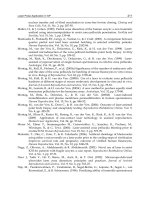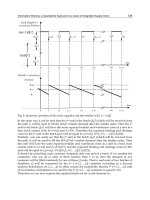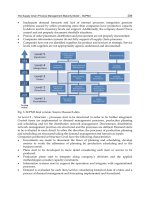Risk Management in Environment Production and Economy Part 12 ppt
Bạn đang xem bản rút gọn của tài liệu. Xem và tải ngay bản đầy đủ của tài liệu tại đây (470.32 KB, 6 trang )
Market Risk Management with Stochastic Volatility Models
209
diversification effects lowering the total economic capital to approximately 305 as the new
risk measure for the corporation as a whole. Capital requirements at 99.9%, 99.5% and 99%
worst-case loss scenarios for the corporation become 450.69, 434.64 and 414.88, respectively,
for the normal distributions case. For the student-t distribution with two (four) degrees of
freedom illustrating a medium (an extreme) heavy tail case, the excess 99.9% and 99.0%
worst case losses grows to 1131.8 (931.4) and 464.1 (424.6), respectively.
Fig. 15. Distributions of VaR and CVaR for Normal and Student-t distributions
The diversification benefits are to be allocated by an amount
i
i
E
x
x
to the ith business unit,
where E is the total risk capital and x
i
is the investment in the ith business unit. By using the
Euler’s theorem we ensure that the total of the allocated capital is E. Euler’s theorem says:
Risk Management in Environment, Production and Economy
210
1
()
N
i
i
I
VaR
VaR x
x
where N is the number of components. We can therefore set
()
ii
i
VaR
Cx
x
where
C
i
is the component VaR for the ith component. We define
E
i
as the
increase in the total risk capital when we increase
x
i
by x
i
. A discrete approximation for the
amount allocated to business unit
i becomes:
i
i
E
y
where
()ob x
Pr
. When we increase
the size of the hydropower generation by 1% its economic capital amounts for market, basis
and operational risk increases to 151.5, 95.95, and 55.55, respectively. New economic capital
(hybrid approach) becomes 301.75, so that
E
HP
= 301.75 – 299.73 = 2.02. Increasing the size
of the network division by 1%, implies an increase in the economic capital for market, basis
and operational risk to 45.45, 38.38 and 25.25, respectively. The total economic capital
becomes 300.11, so that
E
NT
= 300.11 – 299.73 = 0.38. The numbers for telecommunication is
E
TC
= 300.33 – 299.73 = 0.60. The economic capital allocation gains are therefore divided
between hydropower generation, network, and telecommunication by 2.02/0.01 = 202,
0.38/0.01 = 38
25
, and 0.30/0.01=60, respectively.
7. Summaries and conclusions
The paper set out to measure volatility/correlation and market/operational risks for a
general corporation in European energy markets. Starting with a relevant risk discussion the
corporation may perform risk analysis based on either the argument of asymmetric
information relative to owner or based on costs related to financial distress/bankruptcy
costs.
For the Nordpool and the EEX energy markets the paper shows estimates of product and
market volatility/correlations and makes one-step-ahead forecasts. The paper performs a
model-building approach applying Monte Carlo simulation. Stochastic volatility models are
estimated and simulated for risk management purposes. From the power law, the extreme
value theory are used for VaR and CVaR calculations (smoothing out tails). The normal
distribution assumptions make these analyses a relatively easy exercise for
VaR and CVaR –
distributions. Non-normality can be easily implemented applying Copulas. Finally, risk
aggregation is shown for market and operational risk for normal as well as student-
t
distributions.
8. Appendix I : The theory of reprojection and the conditional mean densities
Having the SV model coefficients estimate
ˆ
n
at our disposal, we can elicit the dynamics of
the implied conditional density of the observables
0101
ˆ
ˆ
| , , | , , ,
LLn
py y y py y y
.
Analytical expressions are not available, but an unconditional expectation
0
ˆ
00
ˆ
, , , , ,
L
n
LLn
yy
Eg gy ypy y d d
can be computed by generating an
simulation
ˆ
N
t
tL
y
from the system with parameters set to
ˆ
n
and using
25
Does not equal the total economic capital of 299.73, because we approximated the partial derivatives.
Market Risk Management with Stochastic Volatility Models
211
ˆ
ˆˆ
1/ , ,
n
tL t
Eg Ngy y
. With respect to unconditional expectation so computed,
define
ˆ
01
arg max
ˆ
lo
g
| , , ,
K
n
KKL
Efyyy
, where
01
| , , ,
KL
fyy y
is the SNP
score density. Now let
0101
ˆ
ˆ
| , , | , , ,
KL KL K
fyy y fyy y
. Theorem 1 of Gallant and
Long (1997) states that
0101
ˆ
ˆ
lim | , , | , ,
KL L
K
f
yy y pyy y
. Convergence is with
respect to a weighted Sobolev norm that they describe. Of relevance here is that
convergence in their norm implies that
ˆ
K
f
as well as its partial derivatives in
10
, , ,
L
yyy
converges uniformly over
,1ML
, to those of
ˆ
p
. They propose to
study the dynamics of
ˆ
p
by using
ˆ
K
f
as an approximation. The result justifies the
approach.
Hence, the conditional mean density is from 5 k iterated use of the re-projection procedure.
For every simulation from the normally distributed coefficients, re-projected scores
01
ˆ
| , ,
KL
fyy y
are estimated and the conditional moments (mean and variance) and the
filtered volatility are reported. The power law is also evaluated for the conditional mean
series. Figure 16 report the power law test results for simulated and conditional mean 100 k
data series. The power law seems to work well for both markets and the four series.
()ob x
Pr
Fig. 16. The Power Law for SV-simulated and Conditional mean series: Log plots for return
increases: x is the number of standard deviations ; is the NP / EEX price
increases/decreases.
9. References
Annual reports: www.nordpool.no, www.eex.de, www.apxendex.com, www.powernext.com.
Abramowitz, M. and I.A. Stegun, 2002, Handbook of mathmatiical Functions with Formulas,
Graphs, and Mathematical Tables, U.S. Department of Commerce
(www.knovel.com/book_id=528)
-26
-24
-22
-20
-18
-16
-14
-12
-10
-8
-6
-4
-2
0
0.0000 0.6931 1.0986 1.3863 1.6094 1.7918 1.9459
ln x
Power Law for 100 k Simulated Optimal SV model for NP-EEX Forward/Future Contracts
Front Week-Simulated-Returns K = 8 Front Month-Simulated-Returns
K = 8 EEX Front Month(base)-Simulated-Returns K = 8
EEX Front Month(peak)-Simulated-Returns K = 8
K = 4
K = 8
Risk Management in Environment, Production and Economy
212
Andersen,, T.G., 1994, Stochastic autoregressive volatility: a framework for volatility
modelling, Mathematical Finance, 4, pp. 75-102.
Artzner, P., F. Delbaen, J M. Eber, and D. Heath, 1999, Coherent Measure of Risk,
Mathematical Finance, 9, pp. 203-228.
Black, F. and M. Scholes, 1973, The Pricing of Options and Corporate Liabilities, Journal of
political Economy, 81, pp. 637-654.
Black, F, 1976, Studies in Stock Price Volatility Changes, Proceedings of the 1976 Meeting of the
Business Economic Statistics Section, American Statistical Association, pp. 171-181.
Bollerslev, T., 1986, Generalized Autoregressive Conditional Heteroscedasticity, Journal of
Econometrics, 31, pp. 307-327.
Booth, J.R., R.L. Smith and R.W. Stolz, 1984, The use of interest rate futures by fincial
institutions, Journal of Bank Research, 15, pp. 15-20.
Boyle, P., and F. Boyle, 2001, Derivatives: The Tools that Changed Finance, London Risk Books.
Broadie, M. and P. Glasserman, 1996, Estimating Security Prices under Simulation,
Management Science, 42(2), pp. 269-285.
Cherubini, U., E. Luciano, and W. Vecchiato, 2004, Copula Methods in Finance, Wiley.
Clark, P. K., 1973, A subordinated stochastic Process model with finite variance for
speculative prices, Econometrica, 41, pp. 135-156.
Christoffersen, P. F., 1998, Evaluating Interval Forecasts, International Economic Review, 39,
pp. 841-862.
Credit Suisse Financial Products, 1997, Credit Risk Management Framework
DeMarzo P.M. and D. Duffie, 1995, Corporate incentives for hedging and hedge accounting,
The Review of Financial Studies, 24(4), pp. 743-771.
Demarta, S., and A.J. McNeil, 2004, The t Copula and Related Copulas, Working paper,
Department of Mathematics, ETH Zentrum, Zürich, Switzerland
Dunbar, N., 2000, Inventing Money, The Story of Long-Term Capital Management and the
Legends Behind It, Chichester, UK: Wiley.
Durham, G., 2003, Likelihood-based specification analysis of continuous-time models of the
short-term interestrate, Journal of Financial Economics, 70, pp. 463-487
Engle, R.F., 1982, Auto-regressive Conditional Heteroscedasticity with Estimates of the
Variance of U.K. Inflation, Econometrica, 50, 987-1008.
Engle, R.F., and J. Mezrich, 1996, GARCH for Groups, Risk, pp. 36-40.
Faruqui, A. and K. Eakin (2000), Pricing in Competitive Electricity Markets, Springer.
Fama, E.F., 1963, Mandelbrot and the Stable Paretian Hypothesis, Journal of Business, 36,
pp. 420-429.
Fama, E.F., 1965, The Behaviour of Stock Market Prices, Journal of Business, 38, 34-105.
French, K.R. and R. Roll, 1986, Stock Return Variances: The Arrival of Information and the
Reaction of Traders, Journal of Financial Economics, 17, 5-26.
Gallant, A.R., D.A. Hsieh and G. Tauchen, 1991, On fitting a recalcitrant series: the
Pound/Dollar exchange rate, 1974-1983, in W.A. Barnett, J. Powell, and G.E. Tauchen
(eds.), Nonparamettric and Semiparametric Methods in Econometrics and
Statistics, Proceedings of the Fifth International symposium in Economic Theory and
Econometrics. Cambridge: Cambridge University Press, Chapter 8, 199-240.
Gallant, A.R., D.A. Hsieh and G. Tauchen, 1997, Estimation of stochastic volatility models
with diagnostics, Journal of Econometrics, 81, pp. 159-192.
Market Risk Management with Stochastic Volatility Models
213
Gallant, A.R., and J. Long, 1997, Estimating stochastic differential equations efficiently by
minimum chi-squared, Biometrika, 84, pp. 125-141.
Gallant, A.R. and G. McCulloch, 2010, Simulated Score methods and Indirect Inference for
Continuous-time Models, in Y. AïT-Sahalia and L.P. Hansen, eds. Handbook of
Financial Econometrics, Vol. 1, Elsevier B.V., 427-477
Gallant, A.R. and G. Tauchen, 2010, Simulated Score methods and Indirect Inference for
Continuous-time Models, in Y. AïT-Sahalia and L.P. Hansen, eds. Handbook of
Financial Econometrics, Vol. 1, Elsevier B.V., 427-477
Gnedenko, D.V., 1943, Sur la distribution limité du terme d’une série aléatoire, Ann. Math, 44,
423-453.
Hendricks, D., 1996, Evaluation of Value-at-Risk Models using Historical Data, Economic
Policy Review, Federal Reserve Bank of New York, 2, 39-69.
Hull, J.C. and A. White, 1998, Incorporating Volatility Updating into the Historical
Simulation method for Value at Risk, Journal of Risk, 1, 1, 5-19.
Jamshidian, F., and Y. Zhu, 1997, Scenario Simulation Model: Theory and methodology,
Finance & Stochastics
Jorion, P., 2001, Value at Risk, 2
nd
ed. New York: McGraw-Hill.
J.P:Morgan, 1997, CreditMetrics – Technical Document
Kristiansen, T., 2004, Risk management in Electricity Markets Emphasizing Transmission
Congestion, NTNU
Kupic, P., 1995, Techniques for Veryfying the Accuracy of Risk Management Models,
Journal of Derivatives, 3, pp. 73-84.
Lintner, J. 1965, The Valuation of Risk assets and the Selection of Risky Investments in Stock
Portfolios and Capital Budgets, Review of Economics and Statistics, pp. 13-37.
Mandelbrot, A., 1963, The Valuation of Vertain Speculative Prices, The Journal of Business,
36(4), pp. 394-419.
Markowitz, H., 1952, Portfolio Selection, Journal of Finance, 7, 1, pp. 77-91.
Moore, J., J. Culver and B. Masterman, 2000, Risk management for Middle Market
Companies, Journal of Applied Corporate Finance, 12, (4) pp. 112-119.
Mossin, J., 1966, Equilibrium in a Capital Market, Econometrica, pp. 768-783.
Nance, D.C., C. Smith JR. and C. Smithson, 1993, Determinants of Corporate hedging,
Journal of Finance, 48,pp. 267-284.
Neftci, S. N., 2000, Value at Risk Calculations, Extreme Events and Tail Estimation, Journal
of Derivatives, 7, 3, pp. 23-38.
Newey, W., 1985, Maximum Likelihood specification testing and conditional moment tests,
Econometrica, 2, pp. 550-566.
Noh, J., R.F. Engle, and A. Kane, 1994, Forecasting Volatility and Option Prices of the S&P
500 Index, Journal of Derivatives, 2, 17-30.
Rich, D., 2003, Second Generation VaR and Risk Adjusted Return on Capital, Journal of
derivatives, 10,4,51-61.
Rosenberg, B., 1972, The behaviour of random variables with nonstationary variance and the
distribution of security prices. University of California, Berkeley
Rosenberg, J.V. and T. Schuermann, 2004, A General Approach to Integrated Risk Management
with Skewed, Fat-Tailed Risks, Federal Reserve Bank of New York, Staff report No. 185.
Ross, S.A., 1976, The Arbitrage Pricing Theory of Capital Asset Pricing, Journal of Economic
Theory,13,341-60
Risk Management in Environment, Production and Economy
214
Samuelson, P.A., 1965, Proof that properly anticipated prices fluctuate randomly, Industrial
Management Review,6, pp. 41-49.
Schwarz, G., 1978, Estimating the Dimension of a Model, Annals of Statistics, 6, pp. 461-464.
Sharpe, W., 1964, Capital Asset Prices: A Theory of Market Equilibrium, Journal of Finance,
pp. 425-442.
Shepard, N., 2004, Stochastic Volatility: Selected Readings, Oxford University Press.
Solibakke, Per Bjarte, 2007, Describing the Nordic Forward Electric-Power Market: A
Stochastic Model Approach, Vol 4, pp 1-22.
Solibakke, Per Bjarte, 2009, EEX Base and Peak Load One-Year Forward Contracts.
Stochastic Volatility adapting the M-H Algorithm, Working Paper, Molde
University College, pp, 1 -25.
Stulz, R.M., 2003, Risk Management and Derivatives, Southwestern.
Tauchen, G. and M. Pitts, 1983, The price variability-volume relationship on speculative
markets, Econometrica, pp. 485-505.
Tauchen, G., 1985, Diagnostic Testing and Evaluation of Maximum Likelihood Models,
Journal of Econometrics,30, pp. 414-430.
Taylor, S.J.,1982, Financial returns modelled by the product of two stochastic processes, a
study of daily sugar prices 1961-79. In Time series Analysis: theory and practice 1
(ed. O.D. Anderson), pp. 203-226. Amsterdam: North-Holland.
Taylor, S,J. 2005, Asset Price Dynamics, Volatility, and Prediction, Princeton University Press.
Tufano, P., 1996, Who manages Risk? An empirical examination of risk management
practices in the gold mining industry, The Journal of Finance, 51 (4), pp. 1097-1137.
Zang, P.G., 1995, Barings Bankruptcy and Financial Derivatives, Singapore: World Scientific
Publishing.









